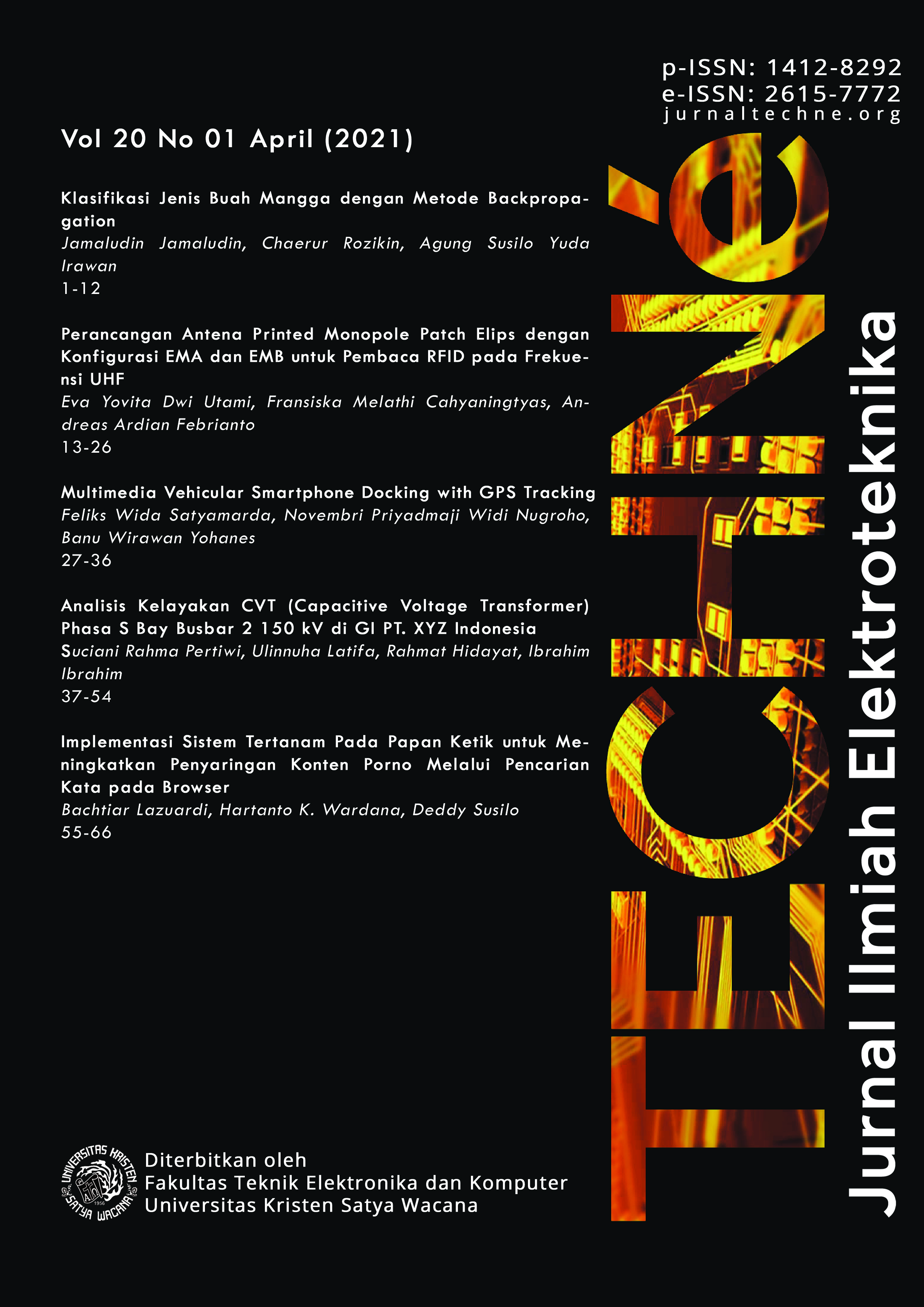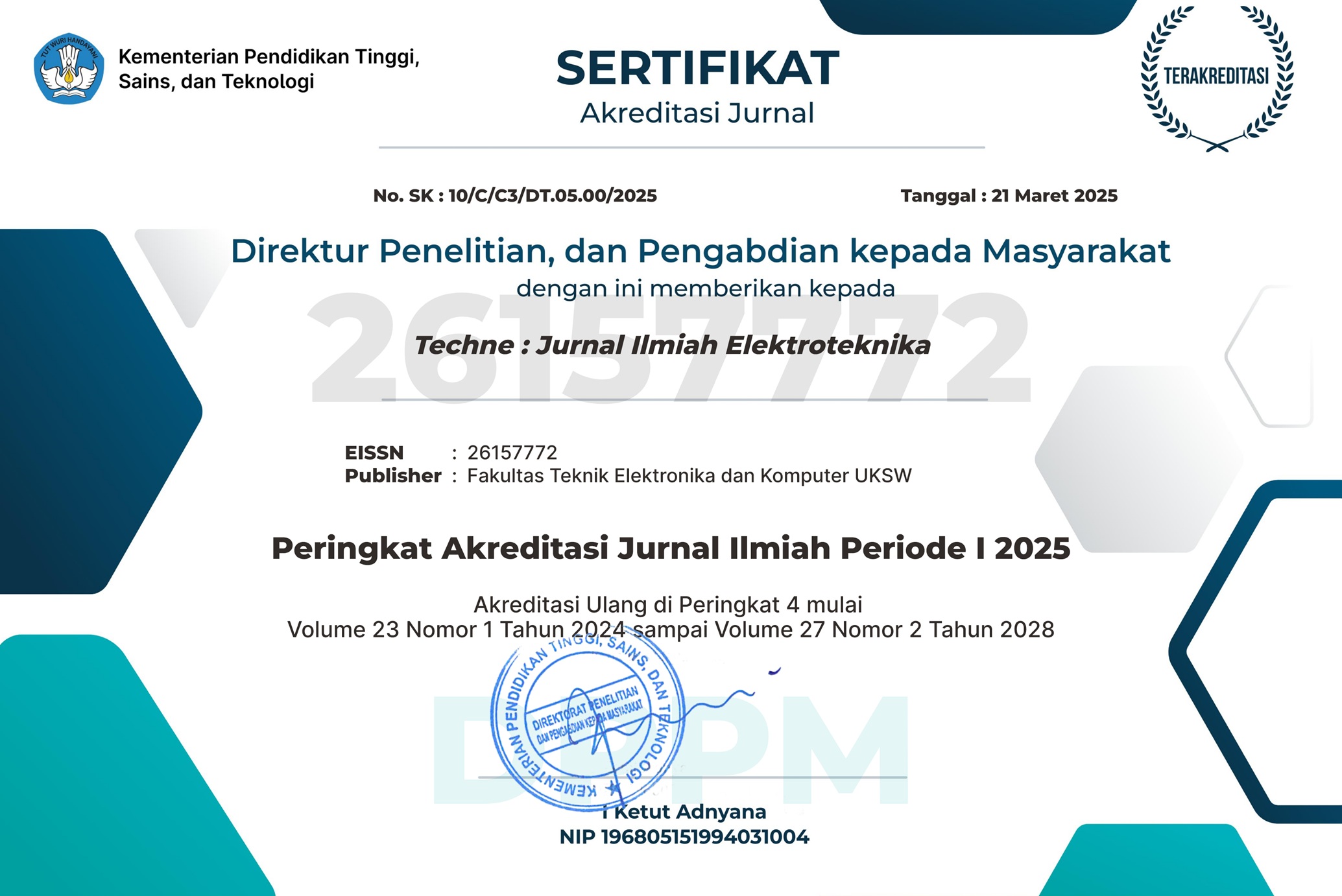Multimedia Vehicular Smartphone Docking with GPS Tracking
DOI:
https://doi.org/10.31358/techne.v20i1.255Keywords:
Vehicle telematics, GPS tracking, smartphone, multimedia servicesAbstract
The Internet of Things (IoT) connecting many electronic devices via internet has been ubiquitous in the last decade. For instance, electric or hybrid cars and autonomous vehicles which are supported by many automotive and IT companies. IoT does not only provide internal monitoring service of the devices, but also the environmental situation. Meanwhile, smartphones are equipped with embedded built-in sensors, and also providing wireless communications. In consequence, vehicular telematics based on smartphone is growing rapidly. This paper proposes a vehicular smartphone docking prototype. It aims not only to provide an affordable alternative to Android Auto and CarPlay, but also to complement them, particularly in vision and security cases. The main issue is that the driver should not be distracted while driving. Such distraction may cause road accident which can lead to severe injuries and even death. Therefore, it is important to design a vehicle smartphone docking to guarantee distraction avoidance and to provide multimedia and localization services. This vehicular smartphone docking architecture consists of an Android smartphone and a Raspberry Pi. Several test drives were conducted with perfect results. Based on the experiment results, this system is able to reduce the number of modules required within a smart vehicle.
Downloads
References
[2] Inc. Tesla, Tesla, available at https://www.tesla.com/, accessed in December 2018.
[3] Inc. Audi, E-tron, available at https://www.audiusa.com/technology/efficiency/e-tron, accessed in December 2018.
[4] Inc. Toyota, Toyota hybrid vehicles lineup, available at https://www.toyota.com/hybrid/, accessed in December 2018.
[5] Inc. Honda, Clarity plug-in hybrid, available at https://automobiles.honda.com/clarity-plug-in-hybrid, accessed in December 2018.
[6] Inc. Nvidia, Self-driving cars, available at https://www.nvidia.com/enus/self-driving-cars/, accessed in December 2018.
[7] M. A. Suwignyo, I. Setyawan, and B.W. Yohanes, “Parking space detection using Quaternionic Local Ranking Binary Pattern,” Proc. of International Seminar on Application for Technology of Information and Communication (iSemantic), pp. 351–355, 2018.
[8] R. D. Airlangga, S. Nugroho, and B.W. Yohanes, “Optimizing ball detection algorithm using center of gravity method and servo pan and tilt controller for humanoid soccer robotic based on Android,” Proc. of Engineering International Conference UNNES Conservation, pp. 142–146, 2013.
[9] S. K. Sungkono, B. W. Yohanes, and D. Santoso, “Decision tree analysis for humanoid robot soccer goalkeeper algorithm,” Proc. of International Annual Engineering Seminar (InAES), pp. 46–50, 2016.
[10] J. H. Pratama, Handoko, and B. W. Yohanes, “Frame Rate Optimization in Traffic Sign Detection, Proc. of International Conference on Cybernetics and Intelligent System (ICORIS),” pp. 246–250, 2019.
[11] J. Rivera and R. van der Meulen, “Gartner says 6.4 billion connected things will be in use in 2016, up 30 percent from 2015,” Gartner, Stamford, CT, USA, Tech. Rep., 2014.
[12] Z. Xu, Z. D. Chen, and H. Nie, “Handheld computers: Smartphonecentric wireless applications,” IEEE Microw. Mag., vol. 15, no. 2, pp. 3644, 2014.
[13] J. Wahlstörm, I. Skog, and P. Händel, “Smartphone-Based Vehicle Telematics: A Ten-Year Anniversary,” IEEE Transactions on Intelligent Transportation Systems, vol. 18, no. 10, 2017.
[14] P. Ekler, T. Balogh, T. Ujj, H. Charaf, and L. Lengyel, “Social driving in connected car environment,” Proc. of 21th IEEE Int. Conf. Eur. Wireless, Budapest, Hungary, pp. 136–141, 2015.
[15] B. Hull et al., “CarTel: A distributed mobile sensor computing system,” Proc. of 4th ACM SenSys, Boulder, CO, USA, pp. 125–138, 2006.
[16] J. C. Herrera, D. B. Work, R. Herring, X. Ban, Q. Jacobsond and A.M. Bayen, “Evaluation of traffic data obtained via GPS-enabled mobile phones: The mobile century field experiment,” Transp. Res. C, Emerg. Technol., vol. 18, no. 4, pp. 568–583, 2010.
[17] Inc. Google, Android Auto, available at https://www.android.com/auto/, accessed in December 2018.
[18] Inc. Apple, Car Play, available at https://www.apple.com/ios/carplay/, accessed in December 2018.
[19] G. Dirgantoro, Konsumen diminta perhatikan perangkat keamanan kendaraan, available at http://otomotif.antaranews.com/berita/517364/konsumen-dimintaperhatikan-perangkat-keamanan-kendaraan, accessed in December 2016.
[20] Y. S. Khraisat et al., “GPS Navigation and Tracking Device,” iJIM5.4, pp. 39–41, 2011.
[21] F. Awada, Speed limit display in a vehicle, US Patent 6,515,596, February 2003.
[22] S. Choi, et al., “Secure video transmission on smartphones for mobile intelligent network,” Int. J. Secur. Appl, Vol. 7, pp. 143–154, 2013.
[23] E.M. Harahap, D. Rachmawati, and H. Herriyance, “Implementasi kompresi teks menggunakan metode Huffman untuk menghemat karakter pada short message service, Alkhawarizmi, vol. 1, no.1, 2012.
[24] B. Furth and D. Kirovshi, Multimedia Security Handbook. CRC Press, 2005.
[25] Government of Republic of Indonesia, Undang-undang Republik Indonesia tentang Hak Cipta, Undang-Undang RI, No. 19, 2002.
[26] Government of Republic of Indonesia, Undang-undang Republik Indonesia tentang informasi dan transaksi elektronik, Undang-Undang RI, No. 11, 2008.
[27] B. W. Yohanes, S. Y. Rusli, and H.K. Wardana, “Location prediction model using Naïve Bayes algorithm in a half-open building,” Proc. of International Conference on Information Technology, Computer, and Electrical Engineering (ICITACEE), pp. 15–19, 2017.
[28] Government of Republic of Indonesia, Undang-undang Republik Indonesia tentang lalu lintas dan angkutan jalan, Undang-Undang RI, No. 22, 2009.








